Threats to Goliath Grouper Populations
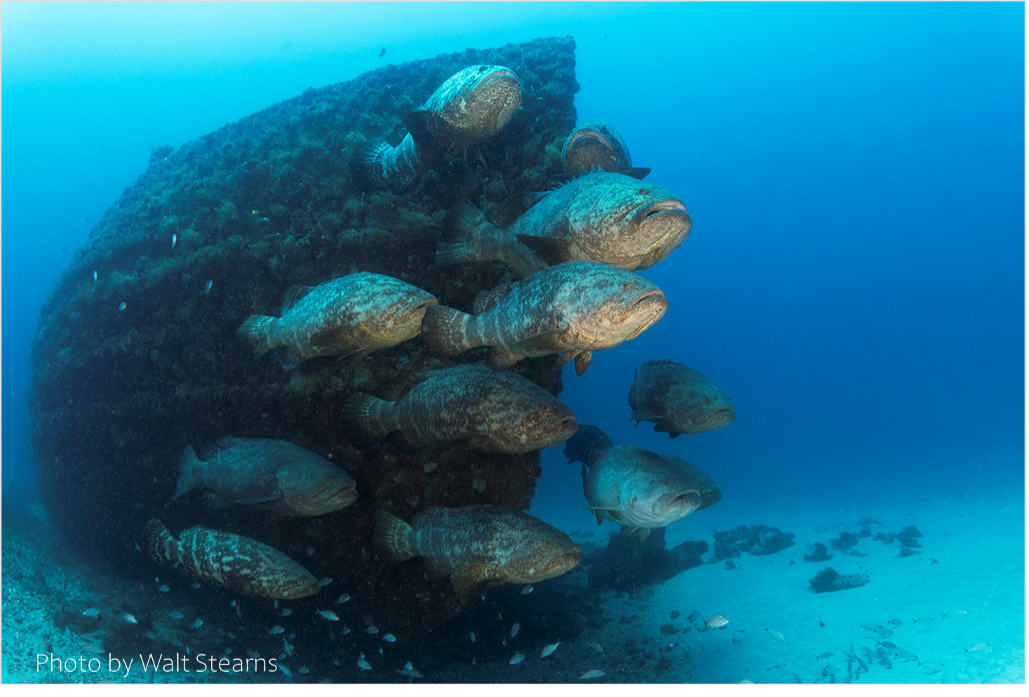
The Atlantic Goliath Grouper, a once abundant species in the southeastern U.S. (especially in Florida), experienced first slow and then rapid declines that started over 100 years ago, initiated by water management projects in South Florida dating back to the early 1900s that reduced the quality and coverage of mangrove habitat essential to juvenile stages of this fish. Intense fishing pressure that started in the 1980s dramatically enhanced the decline while pollution has gained a prominent place with the increased eutrophication in all south Florida waters, contributing to extensive long-lived red tide blooms. Add to this the recent discovery of extremely high mercury loads in these fish, and one sees quickly that the confluence of these threats can have devastating synergistic effects on this and many other species, as well as negative health effects on humans that consume them.
Virtually all of the scientists who have studied the behavior and ecology of the Atlantic Goliath Grouper acknowledge concern for the survival of this species. History for related species suggest that to be warranted. For example, the Giant Sea Bass (Stereolepis gigas) population of the Eastern Pacific has not recovered despite nearly 30 years of limited protection. (http://www.arkive.org/black-sea-bass/stereolepis-gigas/info.html). This species is similar to goliath grouper in that it is large and feeds primarily on crabs and slow-moving fishes. Below we provide a brief overview of these threats.
Habitat Loss
Loss of Critical Habitat for Hundreds of Species
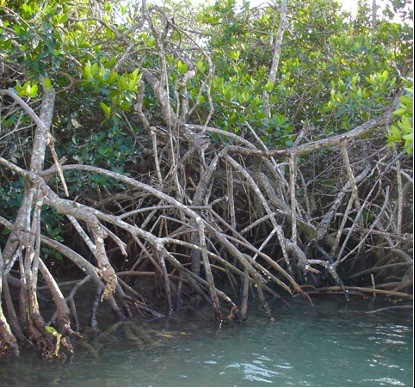 Essential Nursery Habitat — High quality mangroves habitat with similarly high-quality water off southwest Florida, particularly in the Ten Thousand Islands, is key to the ongoing recovery of Goliath Grouper Epinephelus itajara populations. (Koenig et al. 2007, Koenig and Coleman 2009). Juveniles spend their first 5 to 6 years of life in this habitat and it was here in the juvenile population that the first signs of recovery appeared (Cass-Calay and Schmidt 2009).
Essential Nursery Habitat — High quality mangroves habitat with similarly high-quality water off southwest Florida, particularly in the Ten Thousand Islands, is key to the ongoing recovery of Goliath Grouper Epinephelus itajara populations. (Koenig et al. 2007, Koenig and Coleman 2009). Juveniles spend their first 5 to 6 years of life in this habitat and it was here in the juvenile population that the first signs of recovery appeared (Cass-Calay and Schmidt 2009).
NOAA photo.
This extensive habitat, which borders on the Big Cypress Swamp, could provide significant habitat for juveniles during their 5-year estuarine sojourn. Optimism about its capabilities however, have dampened by the fact that the south Florida ecosystem has been altered to such a high degree over the last 100 years (Ogden et al. 2005) that suitable mangrove nursery in all probability presents a bottleneck to the production of this species (Koenig et al. 2007). Most of the mangrove habitat of South Florida has been destroyed by grinding development or has such low and variable water quality due to poor or nonexistent wastewater treatment and runoff from agricultural practices that its value as nursery habitat for any species is tremendously depleted.
Artificial habitat, which is continually expanding as the Florida Fish and Wildlife Conservation Commission deploy more structures designed to enhance local fishing opportunities, are preferred by adult Goliath Grouper, and used as spawning sites off southeast and southwest Florida. Despite the expanding availability of artificial reef habitat, it is the diminishing mangrove habitat that presents a severe bottleneck to the full recovery of Atlantic Goliath Grouper.
Overfishing
Reversal of Fortunes
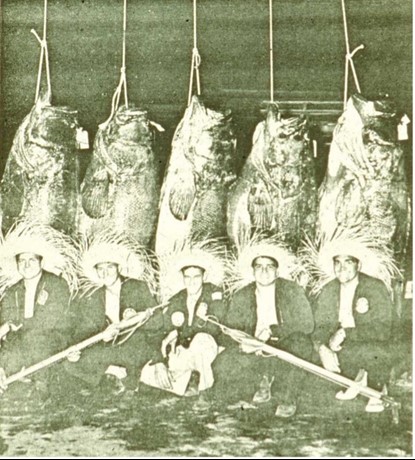 In the United States, intense fishing pressure in the 1970s and 1980s caused many Atlantic Goliath Grouper aggregations to disappear and the population to decline beyond the point of economic extinction. By the late 1980s, the continued decline led a single grouper fisherman to petition the Gulf of Mexico Fishery Management Council (GMFMC) for a fishing moratorium which met virtually no opposition. Both the GMFMC and the South Atlantic FMC closed the fishery in federal waters of the southeastern U. S. entirely in 1990 and throughout the Caribbean in 1993. The U. S. then listed the Goliath Grouper as a candidate species to the Endangered Species List (ESL) in 1991
In the United States, intense fishing pressure in the 1970s and 1980s caused many Atlantic Goliath Grouper aggregations to disappear and the population to decline beyond the point of economic extinction. By the late 1980s, the continued decline led a single grouper fisherman to petition the Gulf of Mexico Fishery Management Council (GMFMC) for a fishing moratorium which met virtually no opposition. Both the GMFMC and the South Atlantic FMC closed the fishery in federal waters of the southeastern U. S. entirely in 1990 and throughout the Caribbean in 1993. The U. S. then listed the Goliath Grouper as a candidate species to the Endangered Species List (ESL) in 1991
throughout its geographic range in U. S. waters — an area extending from North Carolina southward through the Gulf of Mexico. National Marine Fisheries Service, under the authority of the Magnuson-Stevens Fisheries Conservation and Management Act, continues to list the Goliath Grouper as overfished in Reports to Congress on the Status of Fisheries, but no longer lists it as a candidate for the ESL. The International Union for Conservation of Nature (IUCN 2018), however, classifies this species as vulnerable throughout most of its range.
A Glimmer of Hope that Faded — Goliath Grouper numbers started to increase after the 1990 closures instituted by NOAA and the State of Florida, putting them on track towards recovery in Florida waters. This positive trend immediately gave rise to calls to reopen the fishery, despite the fact that losses due to release mortality and illegal harvest resulted in continued overfishing (Porch et al. 2006). The fallacy of reopening the fishery was further revealed by something over which management had no control and could not anticipate — a cold-snap that occurred in 2010 that essentially wiped out the entire juvenile population (Goliath Grouper ages 1-6) thereby reducing recruitment in the following years essentially to zero. There is currently (June 2022) no observable trend that recovery from this event has occurred. Because of these issues and the inherent vulnerability of Goliath Grouper to fishing pressure, caution should be the hallmark of any management decision. Indeed, the scientific evidence supports this view, based on our own research over the last 30 years of studying this species, on our review of the scientific literature, and on reports of colleagues and other scientists throughout the world about ongoing declines at multiple locations. We cover this and other related topics in our paper, Koenig et al. (2020) — Atlantic Goliath Grouper of Florida: to fish or not to fish. Fisheries 45(1).
Full recovery for this or any other species would be indicated by reestablishment of historical age structure, size structure, and geographic range and could be monitoring by evaluating the spatial and temporal dynamics of spawning aggregations by fishery-independent visual and acoustic methods, assuming that Goliath Grouper abundance in spawning aggregations is a correlate of stock size over broader spatial scales. Until that happens, protection is still required accompanied by well-developed monitoring approaches to establish when recovery has occurred.
Pollution
Eutrophication, Red Tide, & Mercury
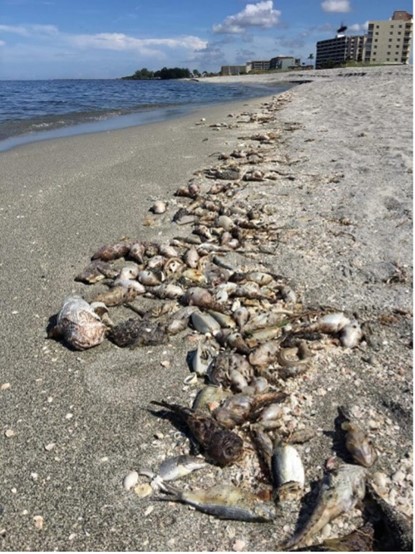 Atlantic Goliath Grouper and many other coastal species have obligatory sojourns in coastal habitats (e.g., mangroves, seagrass meadows, and near-shore algal and hard-bottom habitats) that often expose them to extreme human-induced perturbations, including direct destruction, increases in nutrient loads caused by lack of proper waste water treatment, agricultural run-off, and in some cases either accidental or intentional release of nutrients into the water. These releases can cause a significant reduction in the oxygen in the water and lead to harmful algal blooms such as red-tide, which is caused by the dinoflagellate Karenia brevis. Florida has become quite well known for the growth in the number, size, and longevity of red tide events, causing the deaths of millions of organisms in coastal and nearshore environments. Other sorts of toxicant include pesticides and heavy metals like mercury.
Atlantic Goliath Grouper and many other coastal species have obligatory sojourns in coastal habitats (e.g., mangroves, seagrass meadows, and near-shore algal and hard-bottom habitats) that often expose them to extreme human-induced perturbations, including direct destruction, increases in nutrient loads caused by lack of proper waste water treatment, agricultural run-off, and in some cases either accidental or intentional release of nutrients into the water. These releases can cause a significant reduction in the oxygen in the water and lead to harmful algal blooms such as red-tide, which is caused by the dinoflagellate Karenia brevis. Florida has become quite well known for the growth in the number, size, and longevity of red tide events, causing the deaths of millions of organisms in coastal and nearshore environments. Other sorts of toxicant include pesticides and heavy metals like mercury.
Mercurial views on a viable fishery — Adult Goliath Grouper in the Gulf of Mexico have heavy mercury contamination in muscle and liver tissues as well as in eggs and sperm, thus causing harm to the health of the fish as well as impacting its reproductive potential. Dr. Christopher Malinowski1 (Ocean First Institute https://www.chrismalinowski.org/ ), determined that mercury levels in populations on both coasts of Florida were similar in muscle tissues (up to 3.5 ppm) but differed significantly in the liver, with Goliath Grouper from the Atlantic coast having much higher concentrations in the liver (35 ppm) than those in the Gulf (~25 ppm). But even the 3.5 ppm found in the muscle is considered among the highest ever found in any top level predator (including several species of shark, Swordfish Xiphias gladius, and Tilefish Lopholatilus chamaeleonticeps). Nearly all adult Goliath Grouper exceed the US Food and Drug Administration's (FDA) action level of 1.0 ppm — the level above which the sale of any fish species is prohibited — and far exceed the level that the Natural Resources Defense Council (NRDC) considers "very high." Indeed, at 0.5 ppm, the NRDC recommends that pregnant women and young children avoid these fishes in their diet because of the well-known negative effects of mercury on the health and neurological development of humans. It is hard to imagine a viable fishery based on capture of these fishes.
1see links to Malinowski publications here: https://marinelab.fsu.edu/labs/coleman/publications/
An Alternative View
Dead or Alive? Helping Florida's Economy
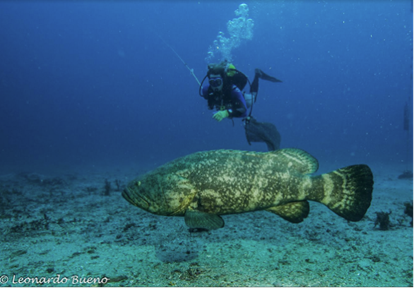 An Atlantic Goliath Grouper caught in a fishery can only generate the market value of that one fish one time (a value deflated by the high levels of mercury in the tissues). However, the economic return from that same fish persisting in the wild will continue to increase because divers can see and photograph it repeatedly throughout its adult lifetime. Knowledge about and contact with this magnificent species could lead to greater support for nonconsumptive ecotourism enterprises.
An Atlantic Goliath Grouper caught in a fishery can only generate the market value of that one fish one time (a value deflated by the high levels of mercury in the tissues). However, the economic return from that same fish persisting in the wild will continue to increase because divers can see and photograph it repeatedly throughout its adult lifetime. Knowledge about and contact with this magnificent species could lead to greater support for nonconsumptive ecotourism enterprises.
Photo by © Leonardo Bueno
Indeed, the dive industry reports tripling revenues over the last few years which they attribute to the resurgence of Goliath Grouper on offshore reefs. Divers from all over the world come to see the spectacle of scores of adult Goliath Grouper aggregating on reefs, with each fish exceeding 300-500 pounds. It is clear that maximum benefit to the fish, to Florida's economy, and to other reef fish (because of habitat-enhancing behaviors of Goliath Grouper) are gained by allowing Goliath Grouper to recover to their natural equilibrium level.

